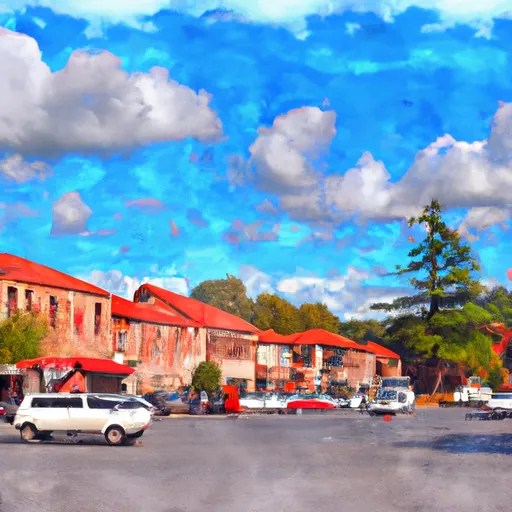-
 Snoflo Premium
Snoflo Premium
Get unlimited access to all our content
With no Ad interruptions! - Start Your Free Trial Login with existing account
Camak
Eden Index
Climate
8.1
•
Recreation
1.2
•
Community
1.4
•
Safeguard
4.0/10

Camak, Georgia is a small town located in Warren County. The climate in Camak is characterized by hot, humid summers and mild winters with occasional snow. The hydrology constituents of the area include the Little River, which runs through the town and provides opportunities for fishing and canoeing. The nearby Lake Strom Thurmond also offers boating and fishing opportunities. Outdoor recreation opportunities in Camak include hiking and camping at nearby State Parks, such as Mistletoe State Park and Elijah Clark State Park. The area also has historical landmarks, including the historic Camak Railroad Depot Museum. Overall, Camak offers a charming small-town atmosphere with outdoor activities and historical attractions.
What is the Eden Index?
The Snoflo Eden Index serves as a comprehensive rating system for regions, evaluating their desirability through a holistic assessment of climate health, outdoor recreation opportunities, and natural disaster risk, acknowledging the profound impact of these factors on livability and well-being.
Climate Health Indicator (CHI): 8.1
Camak receives approximately
1227mm of rain per year,
with humidity levels near 87%
and air temperatures averaging around
17°C.
Camak has a plant hardyness factor of
8, meaning
plants and agriculture in this region tend to thrive here all year round.
By considering the ideal temperature range, reliable water supplies, clean air, and stable seasonal rain or snowpacks, the Climate Health Indicator (CHI) underscores the significance of a healthy climate as the foundation for quality living.
A healthy climate is paramount for ensuring a high quality of life and livability in a region, fostering both physical well-being and environmental harmony. This can be characterized by ideal temperatures, reliable access to water supplies, clean air, and consistent seasonal rain or snowpacks.
Weather Forecast
Streamflow Conditions
Savannah
Area Rivers
Savannah
Snowpack Depths
Savannah
Reservoir Storage Capacity
Savannah
Groundwater Levels
Recreational Opportunity Index (ROI): 1.2
The Recreational Opportunity Index (ROI) recognizes the value of outdoor recreational options, such as parks, hiking trails, camping sites, and fishing spots, while acknowledging that climate plays a pivotal role in ensuring the comfort and consistency of these experiences.
Access to outdoor recreational opportunities, encompassing activities such as parks, hiking, camping, and fishing, is crucial for overall well-being, and the climate plays a pivotal role in enabling and enhancing these experiences, ensuring that individuals can engage in nature-based activities comfortably and consistently.
Camping Areas
| Campground | Campsites | Reservations | Toilets | Showers | Elevation |
|---|---|---|---|---|---|
| Broad River - Strom Thurmond Lake | None | 362 ft | |||
| Towns Bluff County Park | None | 114 ft | |||
| Hesters Ferry - Strom Thurmond Lake | None | 417 ft | |||
| Raysville - Strom Thurmond Lake | None | 381 ft | |||
| Leroys Ferry - Strom Thurmond Lake | None | 374 ft | |||
| Big Hart - Strom Thurmond Lake | 31 | 367 ft | |||
| Clay Hill - Strom Thurmond Lake | None | 358 ft | |||
| Hamburg State Park | None | 353 ft | |||
| Bobby Brown State Park | None | 403 ft | |||
| Mount Carmel - Strom Thurmond Lake | 40 | 380 ft |
Nearby Ski Areas
Catastrophe Safeguard Index (CSI):
The Catastrophe Safeguard Index (CSI) recognizes that natural disaster risk, encompassing floods, fires, hurricanes, and tornadoes, can drastically affect safety and the overall appeal of an area.
The level of natural disaster risk in a region significantly affects safety and the overall livability, with climate change amplifying these risks by potentially increasing the frequency and intensity of events like floods, fires, hurricanes, and tornadoes, thereby posing substantial challenges to community resilience and well-being.
Community Resilience Indicator (CRI): 1.4
The Community Resilience Indicator (CRI) recognizes that education, healthcare, and socioeconomics are crucial to the well-being of a region. The CRI acknowledges the profound impact of these elements on residents' overall quality of life. By evaluating educational resources, healthcare accessibility, and economic inclusivity, the index captures the essential aspects that contribute to a thriving community, fostering resident satisfaction, equity, and social cohesion.

